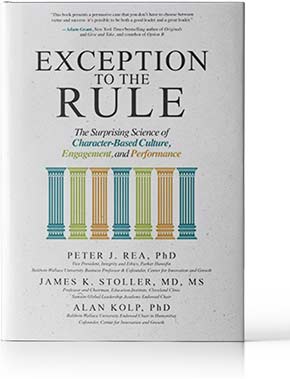About the Book
"This book presents a persuasive case that you don't have to choose between virtue and success: it's possible to be both a good leader and a great leader."

Exception to the Rule
Circumstances change. Convictions don’t.
In today’s unpredictable business environment, leading according to character-based conviction is a rational way to run our organization.
You may have a solid strategy — but without an equally solid culture, you will struggle to execute your strategy. Rather than follow the latest management trends, why not rely on rock-solid virtues — your mooring in a sea of vast and sudden change?
Exception to the Rule helps you create a culture that’s built to last by focusing on seven virtues that cross social, religious, and cultural divides, and have been driving lasting positive results for centuries. Despite obvious cultural differences, the virtues consistently provide a forum to unite than divide people. This is why the ideas in this book have been applied successfully by North American, European, Middle Eastern, Asian, and African leaders.
Using this book as your guide, you’ll be able to identify when and where virtue is at work, recognize the benefits it delivers, and replicate that success throughout your organization. The authors provide practical, actionable steps you can take to create an environment where creativity flows, teams work in alignment, and people want to be challenged. The seven classical virtues together define character-based leadership.
Exception to the Rule is filled with examples, scenarios, and case studies of character-based leadership at work — illustrating how and why this method is so effective. It provides the vision, the framework, and the methods to help build a character-based culture that increases trust, engagement, and teamwork.
The research for this book spans multiple industries, including manufacturing, medicine, business, and higher education. This breadth of research demonstrates how important the virtues are in supporting elite reliable performance in any sector.
The seven classical virtues are behind the greatest of human accomplishments. Why wouldn't they deliver results in your organization?


